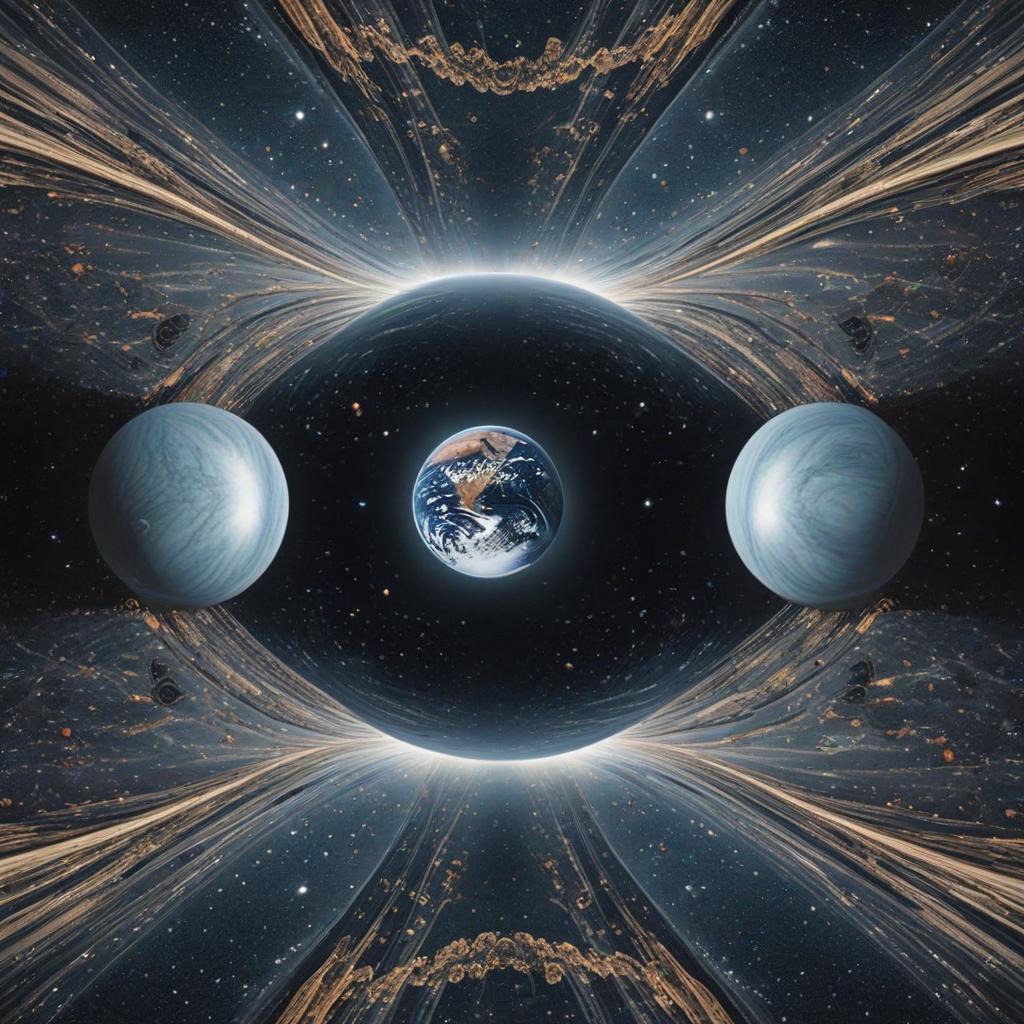Everything is Nothing: The Paradox of Existence and Energy
The idea that “everything is nothing” or that “everything boils down to nothing” has fascinated philosophers, scientists, and thinkers for centuries. It raises profound questions about the nature of existence, matter, and energy. At its core, this concept challenges our everyday perception of the physical world. In this blog post, we’ll explore the science and philosophy behind the idea that, when we break things down to their most fundamental level, they seem to turn into “nothing,” yet something must always exist to account for the world we observe.
The Perception of Objects and Their Essence
From our human perspective, the world is made up of objects: chairs, trees, planets, and people. Each object appears solid, tangible, and distinct from one another. This perception, however, is an illusion built upon layers of complexity. If we strip away these layers, breaking down objects to their simplest form, we reach a point where these distinctions dissolve.
For example, the human body appears solid and complex—a collection of organs, bones, and tissues. But if we go deeper and examine the components of our organs and bones at the molecular level, they are made of atoms. And when we break atoms down further into subatomic particles—protons, neutrons, and electrons—we are confronted with a startling truth: these particles are not “solid” in the way we think of matter. Instead, they are mostly empty space and fields of energy, bound together by fundamental forces.
The Breakdown: From Objects to Energy
Let’s take a step-by-step breakdown of a human being:
- The Physical Body: On the surface, a person seems to be made of flesh, bone, and fluids. Most of our body is composed of water, which consists of hydrogen and oxygen atoms. So, in a sense, we are already breaking down into simpler substances.
- The Molecular Level: Water (H₂O), proteins, fats, and other molecules make up the cells of the body. These molecules are composed of atoms, which are essentially clouds of electrons surrounding a nucleus made of protons and neutrons.
- The Atomic Level: If we zoom in even further, we reach the level of individual atoms. Atoms themselves are mostly empty space. The nucleus, which contains nearly all the mass of the atom, is extremely small compared to the space occupied by the surrounding electrons.
- The Subatomic Level: Beyond the atom, we arrive at subatomic particles like protons, neutrons, and electrons. These, too, are not solid objects but rather excitations in quantum fields. In fact, they are better described as probabilities of existence rather than tangible particles. The nucleus of an atom, for example, is held together by the strong nuclear force, which is a manifestation of energy.
- The Energy Level: Ultimately, as we break everything down, we find that matter itself is just a form of energy. Einstein’s famous equation, E=mc², tells us that mass and energy are interchangeable. So, at the most fundamental level, all that we perceive as matter is actually a manifestation of energy. In a way, everything we see is nothing more than organized energy.
Quantum Mechanics and the Illusion of Solidity
Quantum mechanics further deepens this mystery. At the quantum level, particles like electrons don’t behave like solid objects moving along predictable paths. Instead, they exist in a state of probability, only taking on definite positions when observed. This leads to the conclusion that matter is not solid in the way we perceive it; rather, it is an ephemeral dance of energy and probability.
Particles are governed by the principles of wave-particle duality, which means they exhibit both particle-like and wave-like behaviors. The duality implies that particles can be thought of as excitations or waves in underlying fields. In essence, the solid objects we interact with are merely manifestations of deeper, invisible fields of energy and quantum probability.
This quantum behavior also gives rise to the idea that, fundamentally, everything is “nothing.” Solid matter is largely empty space, and what we think of as tangible objects are mostly voids occupied by flickers of energy fields.
The Paradox of “Nothingness” and “Somethingness”
At this point, you might ask, “If everything boils down to nothing, how can there be something at all?” This paradox is one of the central challenges of both science and philosophy. If the universe consists mostly of empty space and energy, what gives rise to the “somethingness” of the objects we experience?
The answer lies in the interplay between existence and non-existence. The emptiness at the core of atoms is not true “nothingness” in the absolute sense. It is a structured emptiness—a void populated by the potential for existence. Energy and quantum fields fill this space, giving rise to matter and the universe as we know it.
One explanation comes from the quantum vacuum, which is not an empty void but rather a seething, active space filled with virtual particles and energy fluctuations. Even in the absence of matter, there is still energy in the form of vacuum energy. This energy can spontaneously give rise to particles and antiparticles, a process observed in quantum field theory.
Can Something Emerge from Nothing?
This brings us to the age-old question: Can something emerge from nothing? Many scientists and philosophers argue that true “nothingness” does not exist. Even in the vacuum of space, virtual particles are constantly popping in and out of existence, according to the rules of quantum mechanics. This phenomenon suggests that what we perceive as “nothing” is actually a boiling sea of potentiality, where energy fluctuations can give rise to particles and forces.
In the context of the universe’s origin, the Big Bang is often described as the moment when something (our universe) emerged from “nothing.” However, this “nothing” may not be a state of true absence, but rather a state of extremely high potential energy that transitioned into the universe we observe today.
Exploring “Everything is Nothing” From Basic to Advanced Concepts: A Multi-Perspective Approach
The idea that “everything boils down to nothing” can be viewed through many scientific and philosophical lenses, ranging from basic physics to the frontiers of consciousness research. This exploration moves beyond the atomic and molecular scale to look at larger cosmological events like the Big Bang, the nature of black holes, and deeper concepts like singularity and consciousness. These diverse perspectives not only build on the idea that matter is largely empty space but also challenge our understanding of reality itself.
1. The Big Bang Theory: From Nothing to Everything
The Big Bang Theory proposes that the universe originated from an extremely hot, dense point called a singularity about 13.8 billion years ago. This event marks the moment when time, space, and matter as we understand them came into existence. Before this event, it is argued that there was “nothing”—no space, no time, and no matter. Yet, from this apparent nothingness, everything we see in the universe emerged.
Physicists believe the initial state was an incomprehensibly dense point of energy that rapidly expanded, giving birth to all particles and forces that govern the universe today. While this might seem like “something” emerging from “nothing,” the energy that fueled this expansion may have been a fluctuation in the quantum vacuum or some primordial state beyond our current understanding of physics.
The key takeaway from the Big Bang theory is that while we think of the universe as expanding into space, it’s more accurate to say that space itself is expanding. The “nothingness” before the Big Bang may be better understood as an unobservable state rather than true non-existence.
2. Singularity: Where Physics Breaks Down
In both cosmology and black hole physics, the concept of a singularity arises—points where gravitational forces are so intense that space and time break down. A singularity represents a region where conventional physics cannot describe the conditions, and density becomes infinite.
In the context of black holes, matter is crushed into an infinitely dense point, leading to the conclusion that everything that falls into a black hole ultimately becomes “nothing” as it is absorbed into the singularity. However, it’s crucial to note that singularities challenge our understanding of the universe; they suggest a breakdown in the fabric of spacetime, blurring the line between something and nothing.
In a singularity, space, time, and the laws of physics as we understand them cease to function normally. Thus, singularities can be viewed as places where our reality collapses into “nothingness,” at least in terms of the observable universe.
3. Theory of Everything: The Search for the Ultimate Explanation
Physicists have long been searching for a Theory of Everything (ToE)—a single framework that could unify all the fundamental forces of nature: gravity, electromagnetism, the weak nuclear force, and the strong nuclear force. If found, this theory could provide a deeper understanding of how “something” can emerge from “nothing.”
Current theories, such as string theory, propose that at the most fundamental level, all particles are made up of vibrating strings of energy. These tiny strings, too small to observe, are considered the building blocks of the universe. They vibrate at different frequencies, which gives rise to different particles and forces. String theory suggests that matter and energy are manifestations of a more fundamental “something”—yet, if strings are nothing more than energy vibrations in higher dimensions, then our tangible universe is ultimately a product of these abstract entities.
The Theory of Everything, if ever discovered, might provide insight into the deeper layers of reality, showing how our universe could emerge from what seems like nothing, governed by unified principles that transcend traditional matter.
4. Black Holes: The Edge of Nothingness
Black holes represent the boundary between “something” and “nothing” in a profound way. The event horizon of a black hole is the point beyond which not even light can escape. What happens to matter once it crosses this boundary is still a mystery. Some theories suggest that it is compressed into the singularity at the black hole’s core, effectively vanishing from the observable universe.
However, recent research proposes that information about matter falling into black holes is not entirely lost but is encoded on the event horizon, a principle known as the holographic principle. This suggests that even in a black hole, where matter is seemingly reduced to nothing, the information that describes that matter persists in some form, challenging the notion of true nothingness.
In another theory, black holes might be gateways to other dimensions or even other universes, implying that the “nothingness” inside a black hole is just an illusion from our perspective.
5. Quantum Physics and Mechanics: Reality is a Probability
In quantum mechanics, the nature of reality becomes even stranger. The concept of quantum superposition suggests that particles do not exist in a definite state until they are observed. Instead, they exist in a superposition of multiple states simultaneously, described by a probability wave function. When observed, this wave function “collapses,” and the particle takes on a definite form.
At the quantum level, the universe operates in a probabilistic manner rather than a deterministic one. Particles like electrons are not solid objects but rather “smears” of probability, existing in multiple places at once until we observe them. This challenges our classical understanding of “something” because it suggests that, fundamentally, reality is not a set of concrete objects but a field of possibilities.
In quantum mechanics, even the vacuum of space is not truly empty. The quantum vacuum is filled with virtual particles that spontaneously pop in and out of existence, further reinforcing the idea that “nothing” is always teeming with potential energy and existence.
6. The Study of Consciousness: The Observer Effect
Consciousness plays a curious role in modern physics, especially through the observer effect in quantum mechanics. Some interpretations suggest that the act of observation is what causes the collapse of the wave function, effectively bringing “something” into existence out of “nothing” or, more accurately, out of a state of indeterminacy.
Consciousness itself is another area of mystery. Neuroscience has not yet been able to explain fully how the brain, a physical system, gives rise to subjective experience. Some researchers speculate that consciousness could be tied to quantum processes in the brain, potentially revealing new insights into the relationship between something and nothing. If consciousness plays a role in creating reality, it might hint at an underlying structure of the universe where what we perceive as something emerges through our observation, leaving unanswered questions about the fundamental nature of existence.
7. Empirical Evidence: What Does Science Say?
Science provides empirical evidence that challenges the distinction between “something” and “nothing.” Research in particle physics has demonstrated the existence of virtual particles that appear out of the quantum vacuum, providing tangible proof that “nothingness” is far from empty.
One of the most significant empirical discoveries is Hawking radiation, which suggests that black holes are not entirely black. They emit radiation, which slowly causes them to lose mass and eventually evaporate. This radiation arises from the quantum vacuum, where particle-antiparticle pairs spontaneously appear near the event horizon. One of these particles falls into the black hole, while the other escapes as Hawking radiation. This process is a concrete example of “something” emerging from the seemingly empty space of the quantum vacuum.
Moreover, the discovery of the Higgs boson in 2012 further solidified the idea that particles obtain mass through interactions with quantum fields. This demonstrates that the fundamental properties of matter are deeply rooted in invisible forces and energy fields that pervade what we might mistakenly consider to be “nothing.”
Conclusion: The Universe is a Dance of Something and Nothing
As we explore the universe from the scale of subatomic particles to galaxies, we encounter a profound and paradoxical truth: “nothingness” is not truly nothing. Instead, it is filled with potential, energy, and fluctuations. From the quantum vacuum to black hole singularities, what we perceive as empty or void is often brimming with the potential for existence.
The statement “everything boils down to nothing” may best be understood as a recognition of the fundamental emptiness and energy underlying all things. At the smallest scales, matter dissolves into fields of energy and probability. Yet, through the forces of nature, this “nothingness” gives rise to the rich complexity of the universe. Whether through the quantum fields, black hole horizons, or the role of consciousness in shaping reality, our universe exists as a complex interplay between something and nothing, forever intertwined.
The statement “everything is nothing” is a profound commentary on the nature of reality. On one hand, the world is filled with tangible objects—people, planets, stars—that seem to possess independent existence. On the other hand, when we strip away the layers of complexity, we discover that at its core, all matter is energy, and that energy exists in the context of an apparently “empty” universe.
Yet, this “nothingness” is not devoid of significance. The very emptiness is filled with the potential for energy, particles, and forces. In a strange paradox, it is the “nothingness” that allows “somethingness” to exist. Every object in the universe, from a grain of sand to a human being, is a manifestation of the energy that arises from this structured emptiness.
In the grand scheme of things, our understanding of “nothing” and “something” is still evolving. As we delve deeper into the fabric of reality through quantum mechanics, cosmology, and physics, we may come closer to understanding the true nature of existence and the intricate dance between everything and nothing. For now, we are left with the humbling realization that the universe, in all its vastness, is a paradoxical mixture of something and nothing—an eternal interplay of energy and emptiness.





